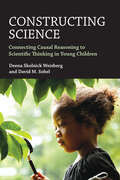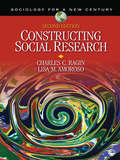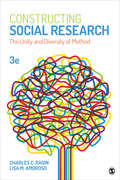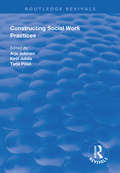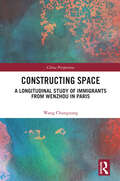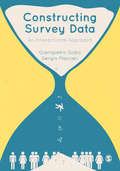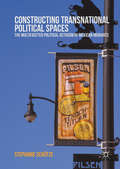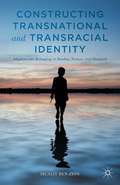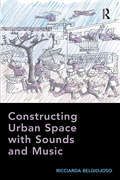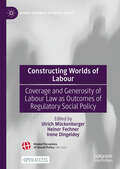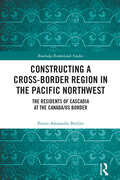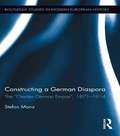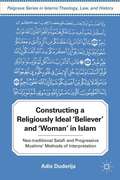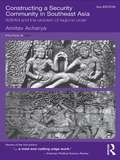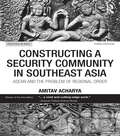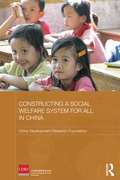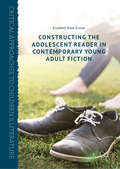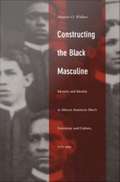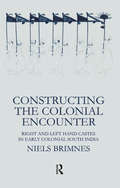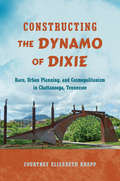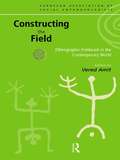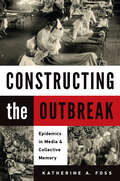- Table View
- List View
Constructing Science: Connecting Causal Reasoning to Scientific Thinking in Young Children
by David M. Sobel Deena Skolnick WeisbergAn examination of children&’s causal reasoning capacities and how those capacities serve as the foundation of their scientific thinking.Young children have remarkable capacities for causal reasoning, which are part of the foundation of their scientific thinking abilities. In Constructing Science, Deena Weisberg and David Sobel trace the ways that young children&’s sophisticated causal reasoning abilities combine with other cognitive, metacognitive, and social factors to develop into a more mature set of scientific thinking abilities. Conceptualizing scientific thinking as the suite of skills that allows people to generate hypotheses, solve problems, and explain aspects of the world, Weisberg and Sobel argue that understanding how this capacity develops can offer insights into how we can become a more scientifically literate society.Investigating the development of causal reasoning and how it sets the stage for scientific thinking in the elementary school years and beyond, Weisberg and Sobel outline a framework for understanding how children represent and learn causal knowledge and identify key variables that differ between causal reasoning and scientific thinking. They present empirical studies suggesting ways to bridge the gap between causal reasoning and scientific thinking, focusing on two factors: contextualization and metacognitive thinking abilities. Finally, they examine children&’s explicit understanding of such concepts as science, learning, play, and teaching.
Constructing Social Research: The Unity and Diversity of Method
by Charles C. Ragin Dr Lisa M. AmorosoConstructing Social Research: The Unity and Diversity of Method, Second Edition is a concise, innovative text designed for Research Methods courses in the Social Sciences. The main goal of this Sociology for a New Century Series text is to show unity within the diversity of activities called social research. The first part of the book tackles questions like "What is social research?" "How does it differ from journalism, documentary film-making, or laboratory research in the natural sciences?" and "What is the researcher's obligation to those he or she is studying?" The book also covers the how the various goals of social researchers shape the strategies they use and the representations of social life they construct. The latter part of the book is structured around the typical emphases of each tradition: qualitative research on commonalities, comparative research on diversity, and quantitative research on relationships among variables. These are not rigid divisions and research designs often blend aspects of each tradition in creative ways. Regardless of the approach, the process of representing social life through research involves a dialogue of ideas ("theory") and evidence ("data"). The model of social research put forth by Ragin and Amoroso is not as restrictive as the scientific method and encompasses social research ranging from research examining the complexities of everyday life to research investigating the power of transnational processes.
Constructing Social Research: The Unity and Diversity of Method (Sociology For A New Century Ser.)
by Charles C. Ragin Lisa M. AmorosoThe updated Third Edition of this innovative text shows the unity within the diversity of activities called social research to help students understand how all social researchers construct representations of social life using theories, systematic data collection, and careful examination of that data. The book tackles questions like "What is social research?", "How does it differ from journalism, documentary film-making, or laboratory research in the natural sciences?", and "What is the researcher′s obligation to those he or she is studying?" Updated throughout with new references and examples, this edition is designed to evoke challenging questions regarding the nature of representation and the ethical challenges facing social scientific researchers. The text moves beyond standard research challenges to push readers to see the complex relationships among ethics, ideas, evidence, and outcomes.
Constructing Social Research: The Unity and Diversity of Method (Sociology For A New Century Ser.)
by Charles C. Ragin Lisa M. AmorosoThe updated Third Edition of this innovative text shows the unity within the diversity of activities called social research to help students understand how all social researchers construct representations of social life using theories, systematic data collection, and careful examination of that data. The book tackles questions like "What is social research?", "How does it differ from journalism, documentary film-making, or laboratory research in the natural sciences?", and "What is the researcher′s obligation to those he or she is studying?" Updated throughout with new references and examples, this edition is designed to evoke challenging questions regarding the nature of representation and the ethical challenges facing social scientific researchers. The text moves beyond standard research challenges to push readers to see the complex relationships among ethics, ideas, evidence, and outcomes.
Constructing Social Work Practices (Routledge Revivals)
by Arja JokinenFirst published in 1999, Jokinen , Juhila and Poso comprises both theoretical/reflexive articles and articles based on empirical social constructionist studies. It provokes new ways of looking at social work practices as interpretative and interactive processes. In addition to this theoretical and methodological contribution, the volume provides empirically based material on the practical implications of an alliance between social work and social constructionism.
Constructing Space: A Longitudinal Study of Immigrants from Wenzhou in Paris (China Perspectives)
by Wang ChunguangThis book presents the findings of a ten-year longitudinal study on the experience of Chinese immigrants from Wenzhou in Paris. The author examines the impact of the evolving spaces people from Wenzhou have built for themselves in the French capital, both within immigrant communities and French society at large. The study discovers that over the course of a decade, immigrants from Wenzhou in Paris have experienced notable changes in the industries they work in, where they live, their organizational structure, how they interact with one another, and their inter-generational dynamics. This book investigates four specific spaces: economic, social, cultural, and policy-related, all of which emerge from immigrants’ integration into local society and in turn impact their own integration. The author aims to reveal the paths and mechanisms of the community and how their social spaces have been constructed while the production mechanism of society from the theoretical point of view is also explored. The book will be of interest to scholars and students of Sociology, Immigration Studies, and East Asian Studies. It will also be an essential reading for those who are interested in Chinese immigration in general.
Constructing Survey Data: An Interactional Approach
by Giampietro Gobo Sergio MauceriEngaging and informative, this book provides students and researchers with a pragmatic, new perspective on the process of collecting survey data. By proposing a post-positivist, interviewee-centred approach, it improves the quality and impact of survey data by emphasising the interaction between interviewer and interviewee. Extending the conventional methodology with contributions from linguistics, anthropology, cognitive studies and ethnomethodology, Gobo and Mauceri analyse the answering process in structured interviews built around questionnaires. The following key areas are explored in detail: An historical overview of survey research The process of preparing the survey and designing data collection The methods of detecting bias and improving data quality The strategies for combining quantitative and qualitative approaches The survey within global and local contexts Incorporating the work of experts in interpersonal and intercultural relations, this book offers readers an intriguing critical perspective on survey research. Giampietro Gobo, Ph.D., is Professor of Methodology of Social Research and Evaluation Methods at the Department of Social and Political Studies - University of Milan. He has published over fifty articles in the areas of qualitative and quantitative methods. His books include Doing Ethnography (Sage 2008) and Qualitative Research Practice (Sage 2004, co-edited with C. Seale, J.F. Gubrium and D. Silverman). He is currently engaged in projects in the area of workplace studies. Sergio Mauceri, Ph.D., is Lecturer in Methodology of Social Sciences and teaches Quantitative and Qualitative Strategies of Social Research at the Department of Communication and Social Research - University of Rome 'La Sapienza'. He has published several books and articles on data quality in survey research, mixed strategies, ethnic prejudice, multicultural cohabitation, delay in the transition to adulthood, worker well-being in call centres and homophobia.
Constructing Transnational Political Spaces: The Multifaceted Political Activism of Mexican Migrants
by Stephanie SchützeThis book analyzes Mexican migrant organizations in the US and their political influence in home communities in Mexico. By connecting multifaceted arenas of Mexican migrant's activism, it traces the construction of transnational political spaces. The author's ethnographic work in the state of Michoacán and in Chicago shows how these transnational arenas overcome the limits of traditional political spaces - the nation state and the local community - and bring together intertwined facets of 'the political'. The book examines how actors engage in politics within transnational spaces; it delineates the different trajectories and agendas of male and female, indigenous and non-indigenous migrant activists; it demonstrates how the local and actor-centered levels are linked to the regional or state levels as well as to the federal levels of politics; and finally, it shows how these multifaceted arenas constitute transnational spaces that have implications for politics and society in Mexico and the US alike.
Constructing Transnational and Transracial Identity
by Sigalit Ben-ZionNorway, Sweden, and Denmark are home to more than 90,000 transnational adoptees of Scandinavian parents raised in a predominantly white environment. This ethnography provides a unique perspective on how these transracial adoptees conceptualize and construct their sense of identity along the intersection of ethnicity, family, and national lines.
Constructing Urban Space with Sounds and Music
by Ricciarda BelgiojosoWhile we are used to looking around us, we are less used to listening to what happens around us. And yet, the noises we produce reveal our way of life, and learning to master them is a necessity. This book aims at drawing the reader’s attention to the sound of the urban environment. The topic is by its very nature complex, as it involves sounds and noises, urban space and social activities. Using an interdisciplinary approach, it examines a heterogeneous selection of experimentations from the domains of music, art and architecture. Significant case studies of pieces of music, public art works and scientific research in the field of urban planning are analyzed, investigating the methods that have been adopted and the aural processes that have been generated. It then uses the findings to reconstruct the underlying theories and practices and to show what might be drawn from these procedures applied to urban planning. The overall objective is to learn to build and enrich space with sound, arguing that there is a need to reconsider architecture and urban planning beyond building, and to look to the world of the arts and other disciplines. In doing so, the book guides the reader toward a sensorial architecture, and more generally toward consciously creating environmental architecture which is sustainable and connects with art and which diffuses a culture of sound.
Constructing Worlds of Labour: Coverage and Generosity of Labour Law as Outcomes of Regulatory Social Policy (Global Dynamics of Social Policy)
by Irene Dingeldey Ulrich Mückenberger Heiner FechnerThis open access book simultaneously addresses both the segmenting and the egalitarian function of individual labour law, in almost all countries of the world, in some chapters following up from its origin to the present. Its socio-legal approach fills gaps for sociological, legal and historical research of regulatory social policy. Labour law is dealt with both in qualitative (theoretical, hermeneutic and historical) and in quantitative manner (with the leximetrics method developing new ways to measure generosity and coverage of law). This is a groundbreaking contribution to regulatory social policy research. By indicating the relevance and the mechanisms of legal segmentation for labour market segmentation, unequal opportunities and social stratification it provides evidence for the assumptions that social segmentation does not only stem from market forces, but also from the law itself. Even the rising impact of egalitarian law cannot fully cope with legal segmentation. The book chapters place particular emphasis on the development in countries of the Global South.
Constructing a Cross-Border Region in the Pacific Northwest: The Residents of Cascadia at the Canada/US Border (ISSN)
by Pierre-Alexandre Beylierexamines this phenomenon in Cascadia, which runs along the Canada/US border in the Pacific Northwest. assesses the impact that increased border security in the wake of 9/11 has had on border residents. will be of interest to researchers across border studies, geography, geopolitics, and cultural studies, as well as to policy makers and other stakeholders with an interest in cross-border cooperation.
Constructing a Cross-Border Region in the Pacific Northwest: The Residents of Cascadia at the Canada/US Border (Routledge Borderlands Studies)
by Pierre-Alexandre BeylierFor residents living at national borders, the divisions between countries are rarely black and white, and often everyday interactions contribute to the creation of a cross-border region. This book examines this phenomenon in Cascadia, which runs along the Canada/US border in the Pacific Northwest. Placing people at the heart of the analysis, the book considers the everyday interactions and links which bind residents together and help to define Cascadia as a cross-border region. The book also assesses the impact that increased border security in the wake of 9/11 has had on border residents. Following a bottom-up approach rather than a top-down approach, the book examines how border security impacts the residents’ mobility, their representations of the border and, potentially the existence of a cross-border identity. Drawing on extensive original qualitative and quantitative data, this book will be of interest to researchers across border studies, geography, geopolitics, and cultural studies, as well as to policy-makers and other stakeholders with an interest in cross-border cooperation.
Constructing a German Diaspora: The "Greater German Empire", 1871-1914 (Routledge Studies in Modern European History #24)
by Stefan ManzThis book takes on a global perspective to unravel the complex relationship between Imperial Germany and its diaspora. Around 1900, German-speakers living abroad were tied into global power-political aspirations. They were represented as outposts of a "Greater German Empire" whose ethnic links had to be preserved for their own and the fatherland’s benefits. Did these ideas fall on fertile ground abroad? In the light of extreme social, political, and religious heterogeneity, diaspora construction did not redeem the all-encompassing fantasies of its engineers. But it certainly was at work, as nationalism "went global" in many German ethnic communities. Three thematic areas are taken as examples to illustrate the emergence of globally operating organizations and communication flows: Politics and the navy issue, Protestantism, and German schools abroad as "bulwarks of language preservation." The public negotiation of these issues is explored for localities as diverse as Shanghai, Cape Town, Blumenau in Brazil, Melbourne, Glasgow, the Upper Midwest in the United States, and the Volga Basin in Russia. The mobilisation of ethno-national diasporas is also a feature of modern-day globalization. The theoretical ramifications analysed in the book are as poignant today as they were for the nineteenth century.
Constructing a Religiously Ideal "Believer" and "Woman" in Islam
by Adis DuderijaWho or what is a religiously ideal Believer and Woman in Islam? This book identifies, compares, and contrasts how two contemporary Muslim groups here termed Neo-Traditional Salafis and progressive Muslims interpret the Qur'an and Sunna in order to construct what each considers to be a religiously ideal concept of a "Believer" and "Woman" in Islam. This is the first work which systematically focuses on identifying and explaining which interpretational mechanisms are responsible for the often very different interpretations of these two concepts.
Constructing a Security Community in Southeast Asia: ASEAN and the Problem of Regional Order
by Amitav AcharyaThis second edition of Constructing a Security Community in Southeast Asia takes the excellent framework from Acharya's first edition and brings it up-to-date, looking at ASEAN's comprehensive and critical account of the evolution of the Association of Southeast Asian Nations (ASEAN) norms and the viability of the ASEAN way of conflict management. Key issues in determining the future stability of the Southeast Asian and Asia Pacific region are covered, including: intra-regional relations and the effect of membership expansion the ASEAN Regional Forum and East Asian regionalism ASEAN's response to terrorism and other transnational challenges debates over ASEAN's non-interference doctrine the 'ASEAN Security Community' and the ASEAN Charter the impact of the rise of China and India and ASEAN's relations with the US and Japan. The new edition will continue to appeal to students and scholars of Asian security, international relations theory and Southeast Asian studies as well as policymakers and the media.
Constructing a Security Community in Southeast Asia: ASEAN and the Problem of Regional Order (Politics in Asia)
by Amitav AcharyaIn this third edition of Constructing a Security Community in Southeast Asia, Amitav Acharya offers a comprehensive and critical account of the evolution of the Association of Southeast Asian Nations (ASEAN) norms and the viability of the ASEAN way of conflict management. Building on the framework from the first edition, which inspired the establishment of the ASEAN Political-Security community, this new edition has been extensively updated and revised based on new primary sources that are not publicly available. Updates for this edition include: Expanded and updated coverage of the South China Sea Conflict and how it affects regional order and tests ASEAN unity Analysis of new developments in the US role in the region, including ASEAN's place and role in the US pivot/rebalancing strategy and the evolution of the East Asian Community, the newest summit-level multilateral group Extensive analysis of the ASEAN Political-Security community An examination of US–China relations and China–ASEAN relations Coverage of ASEAN's institutional development and the controversy over reform of the ASEAN Secretariat. An updated outlook on ASEAN's future as a security community and the issue of ASEAN Centrality in the regional security architecture. The new edition will continue to appeal to students and scholars of Asian security, international relations theory and Southeast Asian studies, as well as policymakers and the media.
Constructing a Social Welfare System for All in China (Routledge Studies on the Chinese Economy)
by China Development Research FoundationChina Development Research Foundation is one of the leading economic think tanks in China, where many of the details of China’s economic reform have been formulated. Its work and publications therefore provide great insights into what the Chinese themselves think about economic reform and how it should develop. This book sets out the general objectives, principles and framework of a proposed new social welfare system for China, putting forward relevant policy recommendations. It provides a comprehensive overview of China’s current welfare services, including retirement pensions, education, health, employment, housing and social security payments, and goes on to cost the proposed new social welfare system and assess the government’s capacity for implementing it. It shows how the new system will, within an integrated framework, provide comprehensive welfare for all, including rural and urban citizens, migrant workers and disadvantaged groups such as rural and urban poor. It also shows how the new system will aim to balance economic and social development whilst maintaining China’s high economic growth rate, increasing domestic demand and promoting economic restructuring.
Constructing the Adolescent Reader in Contemporary Young Adult Fiction (Critical Approaches to Children's Literature)
by Elisabeth Rose GrunerThis book examines the way young adult readers are constructed in a variety of contemporary young adult fictions, arguing that contemporary young adult novels depict readers as agents. Reading, these novels suggest, is neither an unalloyed good nor a dangerous ploy, but rather an essential, occasionally fraught, by turns escapist and instrumental, deeply pleasurable, and highly contentious activity that has value far beyond the classroom skills or the specific content it conveys. After an introductory chapter that examines the state of reading and young adult fiction today, the book examines novels that depict reading in school, gendered and racialized reading, reading magical and religious books, and reading as a means to developing civic agency. These examinations reveal that books for teens depict teen readers as doers, and suggest that their ability to read deeply, critically, and communally is crucial to the development of adolescent agency.
Constructing the Black Masculine: Identity and Ideality in African American Men's Literature and Culture, 1775-1995
by Maurice O. WallaceIn seven representative episodes of black masculine literary and cultural history--from the founding of the first African American Masonic lodge in 1775 to the 1990s choreographies of modern dance genius Bill T. Jones--Constructing the Black Masculine maps black men's historical efforts to negotiate the frequently discordant relationship between blackness and maleness in the cultural logic of American identity. Maurice O. Wallace draws on an impressive variety of material to investigate the survivalist strategies employed by black men who have had to endure the disjunction between race and masculinity in American culture. Highlighting their chronic objectification under the gaze of white eyes, Wallace argues that black men suffer a social and representational crisis in being at once seen and unseen, fetish and phantasm, spectacle and shadow in the American racial imagination. Invisible and disregarded on one hand, black men, perceived as potential threats to society, simultaneously face the reality of hypervisibility and perpetual surveillance. Paying significant attention to the sociotechnologies of vision and image production over two centuries, Wallace shows how African American men--as soldiers, Freemasons, and romantic heroes--have sought both to realize the ideal image of the American masculine subject and to deconstruct it in expressive mediums like modern dance, photography, and theatre. Throughout, he draws on the experiences and theories of such notable figures as Frederick Douglass, W. E. B. Du Bois, Booker T. Washington, and James Baldwin.
Constructing the Colonial Encounter: Right and Left Hand Castes in Early Colonial South India (Nias Monographs #No.81)
by Niels BrimnesThis book offers a systematic analysis of the violent clashes between the South Indian 'right' and 'left' hand caste divisions that repeatedly rocked the European settlements on the Coromandel Coast in the early colonial period. Whereas the Indian population expected the colonial authorities to intervene in the disputes, the Europeans were reluctant to get involved in conflicts which they barely understood. In the nineteenth century the significance of the divisions diminished, a development that has long puzzled historians and anthropologists. In addition, this study addresses the larger issue of the nature of colonial encounters. The rich material relating to these disputes convincingly demonstrates how Europeans and Indians, as they sought to incorporate each other into their own social structure and conceptual universe, participated in a dialogue on the nature of South Indian society.
Constructing the Dynamo of Dixie: Race, Urban Planning, and Cosmopolitanism in Chattanooga, Tennessee
by Courtney Elizabeth KnappWhat can local histories of interracial conflict and collaboration teach us about the potential for urban equity and social justice in the future? Courtney Elizabeth Knapp chronicles the politics of gentrification and culture-based development in Chattanooga, Tennessee, by tracing the roots of racism, spatial segregation, and mainstream "cosmopolitanism" back to the earliest encounters between the Cherokee, African Americans, and white settlers. For more than three centuries, Chattanooga has been a site for multiracial interaction and community building; yet today public leaders have simultaneously restricted and appropriated many contributions of working-class communities of color within the city, exacerbating inequality and distrust between neighbors and public officials. Knapp suggests that "diasporic placemaking"—defined as the everyday practices through which uprooted people create new communities of security and belonging—is a useful analytical frame for understanding how multiracial interactions drive planning and urban development in diverse cities over time. By weaving together archival, ethnographic, and participatory action research techniques, she reveals the political complexities of a city characterized by centuries of ordinary resistance to racial segregation and uneven geographic development.
Constructing the Field: Ethnographic Fieldwork in the Contemporary World (European Association of Social Anthropologists)
by Vered AmitEthnographic fieldwork is traditionally seen as what distinguishes social and cultural anthropology from the other social sciences. This collection responds to the inte nsifying scrutiny of fieldwork in recent years. It challenges the idea of the necessity for the total immersion of the ethnographer in the field, and for the clear separation of professional and personal areas of activity. The very existence of 'the field' as an entity separate from everyday life is questioned.Fresh perspectives on contemporary fieldwork are provided by diverse case-studies from across North America and Europe. These contributions give a thorough appraisal of what fieldwork is and should be, and an extra dimension is added through fascinating accounts of the personal experiences of anthropologists in the field.
Constructing the Little House: Gender, Culture, and Laura Ingalls Wilder
by Ann RominesWith more than thirty-five million copies in print, the Little House series, written in the 1930s and 1940s by Laura Ingalls Wilder and her daughter, Rose Wilder Lane has been a spectacular commercial success. This work examines what elements of the eight books account for the series' enduring power and what the novels tell us about 19th-century culture.
Constructing the Outbreak: Epidemics in Media & Collective Memory
by Katherine A. FossWhen an epidemic strikes, media outlets are central to how an outbreak is framed and understood. While reporters construct stories intended to inform the public and convey essential information from doctors and politicians, news narratives also serve as historical records, capturing sentiments, responses, and fears throughout the course of the epidemic.Constructing the Outbreak demonstrates how news reporting on epidemics communicates more than just information about pathogens; rather, prejudices, political agendas, religious beliefs, and theories of disease also shape the message. Analyzing seven epidemics spanning more than two hundred years—from Boston's smallpox epidemic and Philadelphia's yellow fever epidemic in the eighteenth century to outbreaks of diphtheria, influenza, and typhoid in the early twentieth century—Katherine A. Foss discusses how shifts in journalism and medicine influenced the coverage, preservation, and fictionalization of different disease outbreaks. Each case study highlights facets of this interplay, delving into topics such as colonization, tourism, war, and politics. Through this investigation into what has been preserved and forgotten in the collective memory of disease, Foss sheds light on current health care debates, like vaccine hesitancy.
